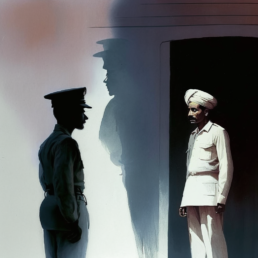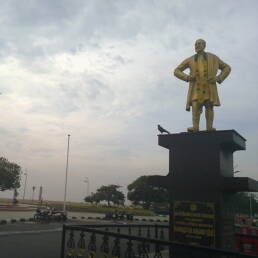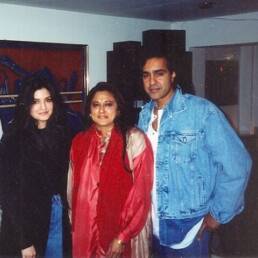Rumour has it there once was an Urdu magazine so popular that it was smuggled across the border and sold for exorbitant prices. Hard to believe?
In the early 20th century, there was a surge and disruption in the way Urdu was used. From being a language of Tehezeeb it started becoming a language of rebellion. When the words of Rashid Jahan and Sajjad Zaheer sparked flame and anger, long-lasting changes in Urdu discourse started taking place.
Others wanted to make Urdu heard in a different way. With the coming of the Talkies, early 20th century Cinema in India was gaining new ground. With that came the opportunity for a new kind of discourse.
The advent of film journalism in undivided India probably started in Lahore where ‘Cinema and Chitra’, published in the late 1920s, was the first to make some real dent in this new field of journalism. The language of communication was primarily Urdu.
Urdu was and still is deeply intertwined with the Hindustani-speaking parts of the country, and it was from around the areas of Lucknow, Lahore, and Delhi, where people went into the glittering film industry to make a mark.
It’s not surprising that Urdu as a language became a mainstay in the early rising days of the Film industry. Shama began publication in 1939 with Yusuf Dehlvi, a successful Delhi businessman who had dealings in real estate and leather, as its proprietor.
Shama was conceived as a combination of religious and literary magazines. What made it stand out was its ability to combine and present its hybrid nature in an articulate & acceptable manner without delving into cheap slander.
Priced at two annas a copy, the first issue had this couplet on its cover:
Lo shama hui raushan, aane lage parwaane,
Aaghaaz jab aisa hai, anjaam khuda jaane
It didn’t receive instant popularity and Yusuf and his family had to really dig deep. However, the heavy usage of Urdu in the industry was a big help. Urdu Poetry was used in the form of song lyrics and many Urdu novels and plays were even used as film screenplays.
Many of these writers who regularly contributed their poems and short stories on Shama were also involved heavily with the film industry, working on dialogues and screenplays. As the motion pictures started gaining popularity, so did Shama.
The era of Urdu Magazines had only begun. Partition led to a sizable influx of Urdu readers in India and for them, Shama became an addiction. But Shama didn’t just lie on their laurels. Their contributors were some of the best and most well paid names in the industry.
Among their contributors were writers like Rajinder Singh Bedi, Ismat Chughtai, and Krishan Chander, and celebrated poets like Jigar Moradabadi and Firaq Gorakhpuri. Regular film columnists included award-winning names such as K.A Abbas and Rahi Masoom Raza.
By the 1950s, almost the entirety of the Delhvi clan, including Yusuf’s three sons, Younus, Idrees, and Ilyas, and some of their wives, was in the business. Shama’s commercial success even led to spin-off publications.
There was Bāno (Lady), a magazine specifically for women, Khilaunā (Toy) for children, the crime/spy magazine Mujrim (Criminal), and others, all under the Shama Umbrella. Yusuf hadn’t only created a successful business but also a nuanced space for articulate discussion.
Though the records haven’t survived the tides of time, Shama was supposedly the first monthly Indian journal of any kind in any language to surpass the 100,000 subscribers milestone as early as the 1950s, selling almost 1.5 lakh copies a month.
Such was its popularity that it was ferried across the border in large numbers. Custom officers would often ask, “Is there anyone who is not carrying Shama?” It had become a commodity that people wouldn’t think twice about spending a lumpsum on.
What added to the craze was the Adabi Muamma, monthly crosswords puzzles, which carried a hefty prize money for the winners. It even got a mention in the Shabana Azmi Starer Anjuman, released in 1986, which was considered a rare distinction for a film magazine.
Shama was loved by the stars. Dharmendra was heard saying, “I’ve been diligently reading Shama since the time I was studying in the 9th…can say this without any hesitation that my desire to get into films was kindled by Shama”.
The likes of Raj Kapoor, and Waheeda Rehman would often visit the Shama Kothi (Delhvi House), as did the likes of Meena Kumari, Nimmi, and Jayant. There was even a rumor that it was Yusuf Dehlvi who persuaded Sunil Dutt to allow Nargis to act in Raat Aur Din.
The 1990s may have been a boom for many, but for Shama and its many contemporaries, it was twilight. The Shama office closed down in 1999, bowing down after almost 6 decades of relentless pursuit of literary eminence.
Given the kind of vitriol the language receives today, it’s hard to imagine that not so long ago an Urdu Magazine was mainstream and popular. How it wowed its readers for all those years without ever letting its standards down is something many of us can learn from even today.
Sources: The Golden Age by Yasir Abbasi – (https://indianquarterly.com); The Filmī-ʿIlmī Formula: Shama Magazine and the Urdu Cosmopolis by Afroz Taj – Journal of urdu studies (brill.com/urds); Yeh Un Dinoñ Ki Baat Hai: Urdu Memoirs of Cinema Legends by Yasir Abbasi for Bloomsbury.




